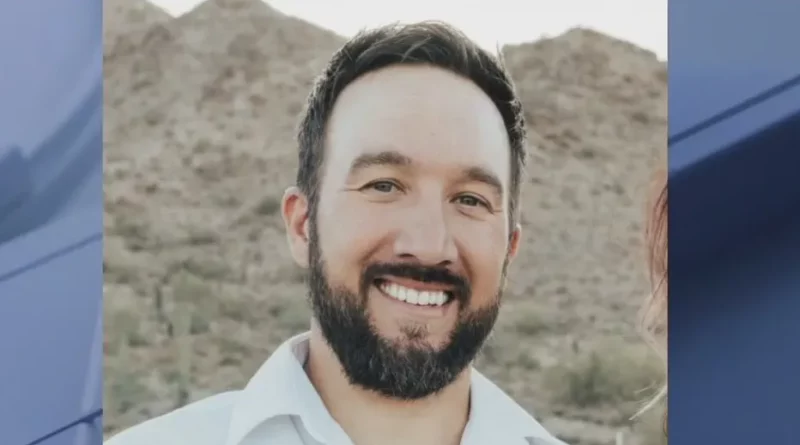Nick Cordova Killed While on FaceTime in Gilbert Arizona
Nicholas “Nick” Cordova was a familiar face in Gilbert, Arizona—a devoted husband, doting father, and ambitious entrepreneur whose warmth and dedication endeared him to family, friends, and customers alike. Born in the mid-1970s, Nick met his future wife Alysha at a family celebration in 2003. Their courtship blossomed into marriage in October 2011, and they welcomed two children: son Cruize in 2012 and daughter Capri in 2015. To those who knew him, Nick was generous with his time and spirit—whether teaching his children bedtime songs, offering a discount to elderly clients, or volunteering at local youth sports events.
In September 2018, Nick seized the opportunity to become co-owner of Gilbert Air, Heating and Cooling. While his partner, David Sweetman, maintained a low profile, Nick steered daily operations—managing technicians, ensuring quality work, and nurturing customer relationships. Reviews praised his integrity: he would often save clients money by correcting unnecessary repairs suggested by competitors. Nick’s dream was to grow the business over five years, sell his share, and retire early to focus on family adventures. Instead, he devoted long hours to the company, driven by the promise of a secured future for his loved ones.
Outside work, Nick was an avid outdoorsman. He organized family camping trips in the high country when pandemic restrictions loosened, and he took pride in finishing home projects—installing a tire swing, customizing a treehouse, and planting a vegetable garden. His home brimmed with photographs capturing moments of laughter, from Cruize’s first soccer goal to Capri’s drawing of her parents holding hands. These memories now underscore the life he cherished and the legacy left behind.
The Fateful Evening: May 27, 2020
On May 27, 2020, the routine of an ordinary workday transformed into harrowing tragedy. At approximately 5:25 p.m., Nick sat at his desk in Gilbert Air’s office—an unassuming building on the corner of Guadalupe and Cooper Roads—on a FaceTime call with his children. Cruize eagerly demonstrated a TikTok trick, giggling into the camera, while Capri waited her turn. Inside their home, Alysha was preparing dinner, comforted by the sight of Nick’s beaming face on her phone screen.
Three minutes later, Capri’s panicked whisper pierced the calm: “Something is wrong with Dad.” The phone clattered to a desk, its camera blinded by white pixels, but the microphone remained live. Alysha heard muffled thumps, as if someone were striking Nick, followed by scuffling footsteps and a piercing yell. At 5:28 p.m., she grabbed her phone, launched 911, and kept the FaceTime call active. Through tears, she reported, “Someone came in and is beating him. I think they have a gun.”
From the live feed came a second voice: “Dave.” It was Nick’s partner, David Sweetman. Alysha implored him to answer, but only distant groans and muted panic answered back. Then the line went dead. Alysha clutched two phones in trembling hands, the kitchen clock reading 5:30 p.m. She stayed on the line with dispatchers until officers arrived.
Crime Scene and Initial Response
Gilbert police roared onto the scene moments later. Inside the office, they found Nick’s body near the entrance—vital signs extinguished by gunshot wounds to his back and head. Papers were strewn across the floor; stacks of cash lay untouched; cell phones and even a potato, pierced by a bullet fragment, bore witness to the frenzied struggle. At a desk, David Sweetman cradled his own 9 mm Sig Sauer and sported a head wound consistent with a blunt force blow. He claimed two masked intruders had burst in, one knocking him unconscious, the other fatally shooting Nick before both fled.
Detectives quickly cataloged the scene: footprints in the carpet, shell casings from multiple shots, a spent cartridge lodged in a chair leg. Though Sweetman’s account shaped the initial robbery theory, inconsistencies soon emerged. The volume of cash left behind and the absence of other valuables contradicted a simple burglary. Neighbors reported no gunfire—no echo of violence that would shatter glass in nearby offices—yet dispatch logs recorded Alysha’s frantic plea for help.
Without waiting, investigators secured internal surveillance footage showing two men in bright construction gear chasing Nick through office aisles. Those tapes remain under seal, withheld from public release. Meanwhile, outside cameras at a neighboring Arco gas station captured a heavyset man pumping gas at 5:33 p.m. and driving off in a distinctive two-tone red and silver Ford F-150. The images became the case’s first public clue.
Surveillance Breakthroughs and Dead-End Leads
Public appeals followed within days. Police released still frames of the suspects: one tall and slender, the other shorter and stocky, both in high-visibility vests and hard hats. Witness statements placed them in a white pickup earlier that afternoon, conflicting with gas-station footage. Volunteers combed social media, offering reward tips; amateur sleuths debated details on web forums.
Inside the cold case unit, ballistic experts analyzed shell casings for unique markings. They traced them to a 9 mm model used in multiple Phoenix-area crimes—but no definitive match emerged. Cell tower records were examined to triangulate the suspects’ phones; ring-down analysis mapped Nick’s digital footprint in the final minutes but identified no unusual contacts. Polygraph tests were administered to dozens of potential witnesses, all inconclusive.
A later tip suggested the getaway truck was stolen and repainted, explaining registration voids. Another claimed the taller suspect was seen at a scrapyard the next morning, but investigators found no corroborating footage. Over time, the lead list grew thin—an ever-shifting tapestry of unverified claims, each promising promise yet delivering no conviction.
Forensic Analysis and Advanced Techniques
As the case grew cold, new technologies offered glimmers of hope. In 2024, detectives partnered with a university lab to enhance surveillance clarity, employing AI-driven image reconstruction. The still of the F-150 was processed to reveal unique bumper damage and a partial license imprint. DNA swabs from interior door handles underwent next-generation sequencing, uncovering a partial profile that awaited database matches.
Audio experts examined the FaceTime recording’s ambient sounds—muffled thuds, a distant siren—to approximate room acoustics and validate Sweetman’s timeline. Combining audio forensics with 3D crime-scene modeling, they reconstructed the sequence: two men entered within seconds, one tackled Sweetman from behind while the other pursued and shot Nick twice as he fled toward a supply closet. The silent partner’s sudden appearance in minutes-old gas-station footage remains a critical puzzle piece.
Yet every advanced lead demanded exhaustive vetting, stretching resources. Budget approvals stalled further DNA comparisons, and equipment bookings delayed audio analysis. Meanwhile, the statistical probability of matching the partial DNA hit dwindled as databases expanded faster than investigative capacity.
Family’s Quest for Justice and Public Outcry
Denied closure, Alysha and her children refused to surrender to despair. They ignited “Noise for Nick,” a grassroots campaign to keep the case in the public eye. Social-media pages share videos of Capri and Cruize pleading for information, interspersed with photos of Nick’s gentle smiles. The family addressed the Gilbert Town Council, urging officials to release body-camera and office surveillance footage. They organized a phone-tree network calling the non-emergency line, demanding in-person updates from detectives.
Silent Witness bolstered its reward from $10,000 to $20,000, posting fliers citywide. Local news outlets revisited the story on anniversaries, interviewing Nick’s parents—Theresa and Jorge Cordova—who spoke of their son’s unwavering generosity. Podcasts devoted full episodes to dissecting the timeline, speculating on financial motives, and questioning why a co-owner’s actions drew limited scrutiny. Community vigil attendees lit candles before the office façade each May, leaving flowers and handwritten notes. A scholarship in Nick’s name awards a college fund to an aspiring entrepreneur, ensuring his legacy inspires future generations.
Despite these efforts, friction surfaced. Family members decried sporadic investigator communication and delays in records requests. Police chiefs countered, affirming a “steadily progressing investigation” and promising new leads in 2025. Public trust wavered as local talk-radio hosts criticized both sides, igniting heated debates about law-enforcement transparency.
The Life Insurance Dispute and Legal Entanglements
Overlaying the detective work was a separate battle: the fight over Nick’s $8 million life insurance. Within months of becoming co-owner, he secured two policies—$3 million for his wife, $5 million for the business. In December 2018, however, nominees were amended—unbeknownst to Alysha—to name Gilbert Air as sole beneficiary, effectively disenfranchising his family.
Three days after Nick’s death, Sweetman pressed Alysha to file the claim, allotting her a $500,000 share. Sensing deceit, Alysha filed suit, alleging fraudulent beneficiary changes. American National Insurance intervened in federal court to adjudicate competing claims. Discovery unearthed Sweetman’s past: in 2013, following his divorce from neurologist Laura Sweetman, he received a payout after her accidental drowning and overdose. Attorneys pointed to a pattern of opportunistic policy adjustments, while defense counsel argued normal corporate practice to protect business continuity. In late 2023, a settlement split proceeds equally: $4 million to Alysha, $4 million to Gilbert Air—closing the civil chapter but leaving the murder motive unresolved.
Unsolved and Unforgotten
As summer 2025 dawns, Nick’s homicide remains Gilbert’s most haunting cold case. No arrests, no court dates, no courtroom drama—only a mosaic of blurred images, partial DNA traces, and unanswered questions. Gilbert PD maintains the file is active, detectives re-opening leads as tips surface. A recent anonymous tip matched the reconstructed DNA to a known offender, now under review; the F-150’s bumper damage is being cross-checked against crash-repair invoices. Yet each promise of progress yields cautious optimism rather than justice.
For Alysha, Cruize, and Capri, the void is measured in birthdays without their father, milestones unshared, and a home that echoes with absence. Friends recall Nick’s laugh, colleagues speak of his mentorship, and community murals depict his smiling face—ensuring memory outlasts silence. Each FaceTime call carries the faint hope that someone, somewhere, will recognize a detail, speak up, and finally answer the question echoing five years on: who took Nick Cordova’s life?
Discover more from City Towner
Subscribe to get the latest posts sent to your email.





Seems obvious the partner was in on it. Maybe the wife too?